This Sous Vide Turkey Breast is cooked slow and low in the sous vide to guarantee the most perfectly tender, juicy, succulent results!
Flavored with a lemon, garlic and herb spice mix, this sous vide turkey roulade is a great alternative to a whole bird for Thanksgiving or Christmas.
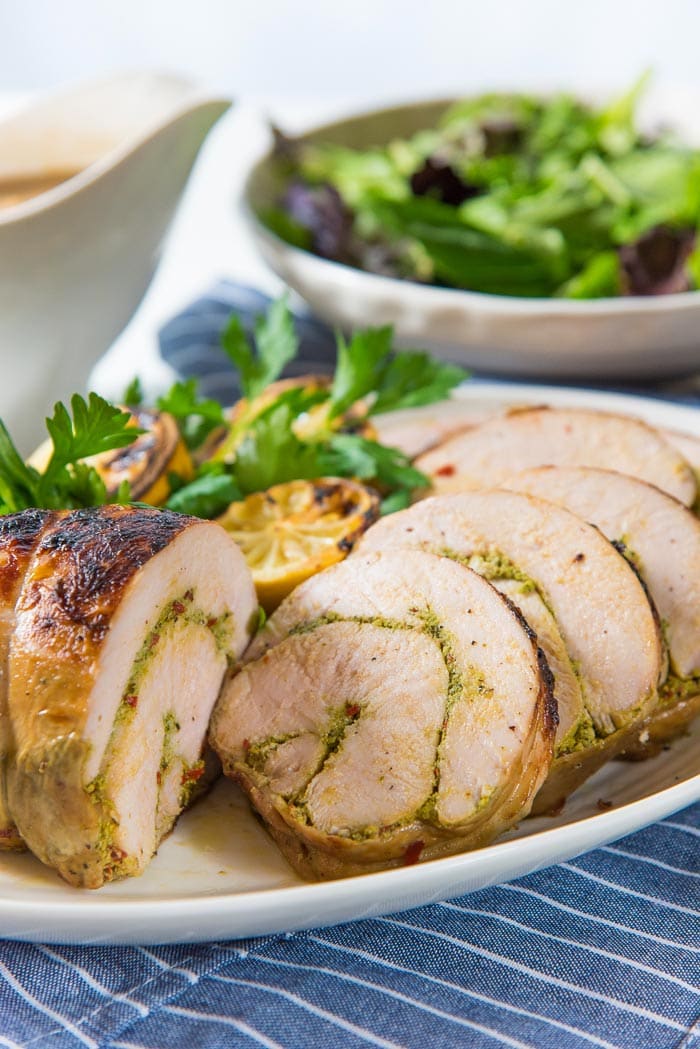
- Why this sous vide turkey breast recipe works
- Ingredients for this recipe
- What is sous vide?
- Why sous vide turkey?
- Why sous vide is one of the best ways to cook turkey breast
- How to sous vide turkey breast
- Tips to ensure the most juicy, succulent sous vide turkey breast
- Flavor variations
- How to serve this sous vide turkey breast
- Storage instructions
I’ve discussed the technique and plenty of tips in the post below to ensure that you make the best sous vide turkey breast for your Thanksgiving and Christmas spread this year!
Last time, I shared how to cook a perfectly slow roasted turkey roulade in the oven. Today, I’m sharing with you an even better and more precise way to cook a beautifully moist, succulent turkey roulade (turkey roll) in the sous vide!
The most involved part about making a turkey roulade is actually prepping the turkey roll. I shared a detailed, step by step guide right here on how to make a turkey roulade, staring with a full turkey breast cut (on the bone, and with the skin).
Once you’ve done that, you can use either your oven (oven roasted turkey roll) or make a sous vide turkey breast. The beauty about using a sous vide is that it’s nearly impossible to overcook this turkey roulade. It’s really that foolproof.
Why this sous vide turkey breast recipe works
- I provide a detailed, step by step guide on how to perfectly debone a whole turkey breast yourself, and how to make a turkey roulade from scratch! Even if you have never made a roulade before, this guide will make it very easy and straightforward.
- Just like my oven roasted turkey roll, this is also a great way to cook turkey for Thanksgiving or Christmas for a small gathering OR if you want more meat but don’t need to cook a whole second bird.
- This post also shows you other flavor variations to adjust the recipe to your taste buds.
- The benefit of a roulade is that the cylindrical/roll shape allows for very even cooking, and cut even slices when serving this turkey roast to your guests.
- The benefit of sous vide is that you are guaranteed not to overcook the turkey breast! In fact, you’ll get the most juicy and succulent turkey breast this way.
- Plus, this is a show stopping turkey roast that will impress anyone.
Ingredients for this recipe
For the roulade
- Whole turkey breast, bone in and skin on. OR turkey breast already made into a roulade/roll by your butcher
- Parsley
- Cilantro
- Sugar
- Lemon rind
- Lemon juice
- Chili
- Oil or butter
- Salt
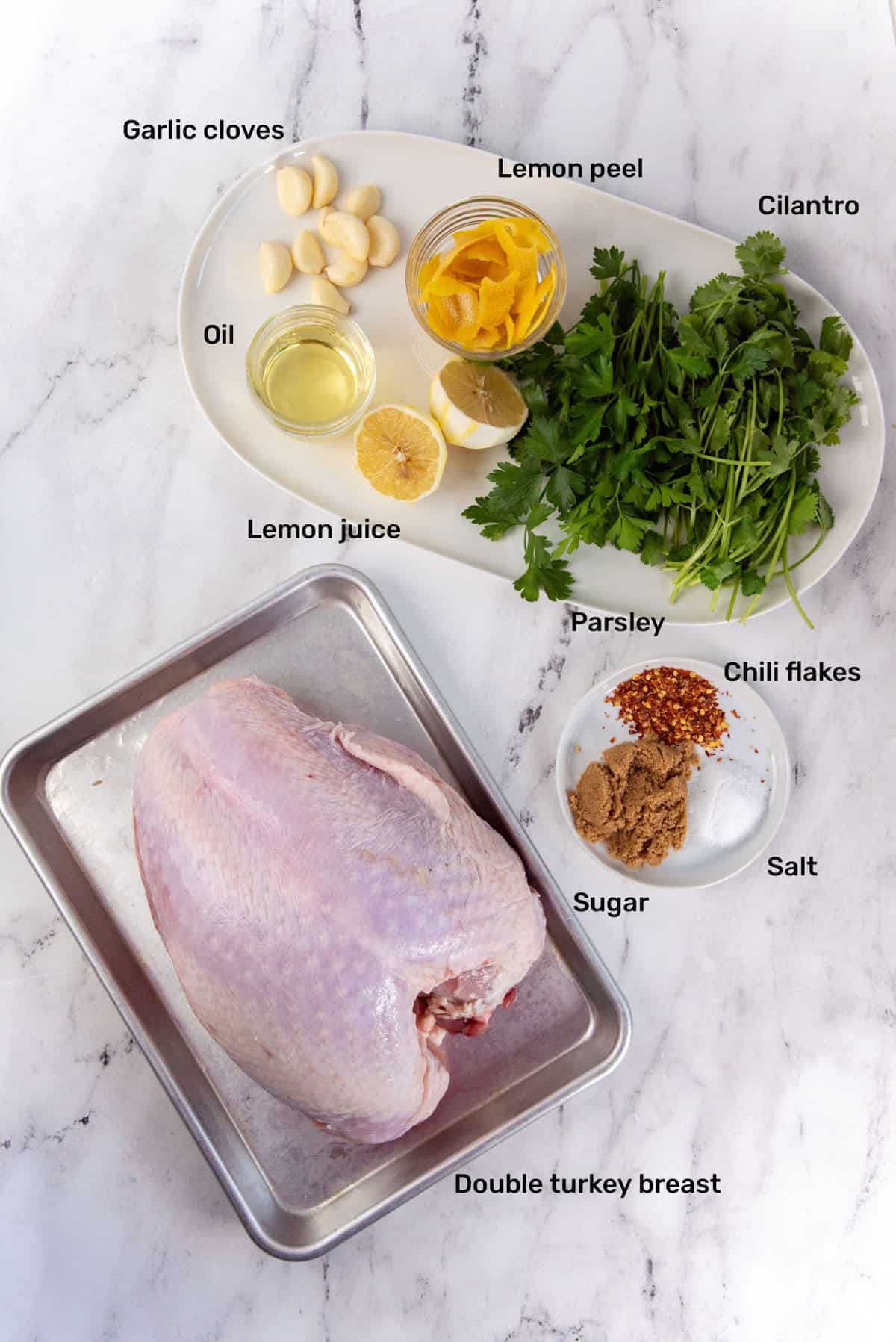
For the gravy
- Au jus from the roast
- Chicken stock
- Butter and flour for the roux
- Salt and pepper for seasoning
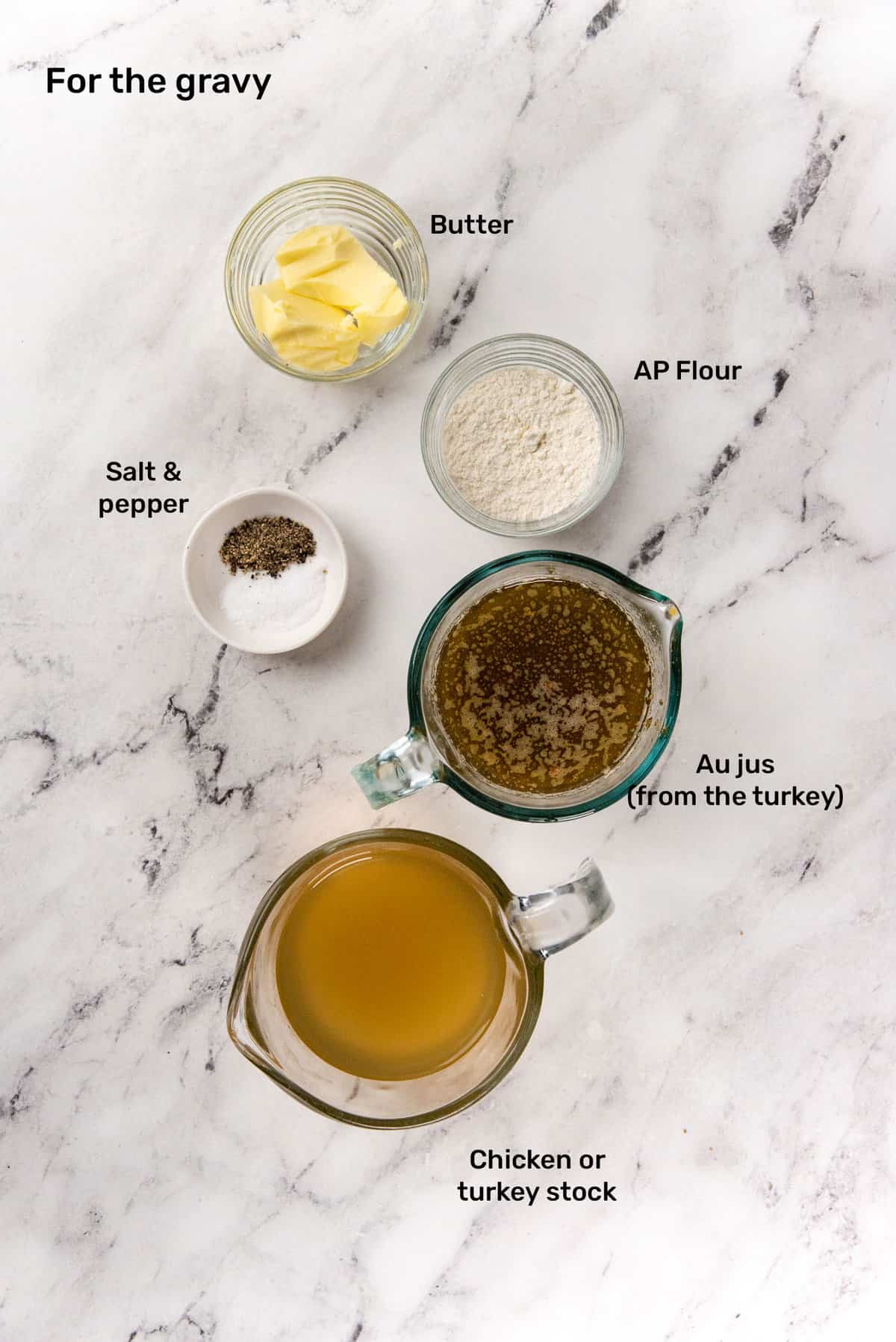
What is sous vide?
It sounds fancy, but it’s a pretty simple cooking technique, where your food is first sealed in a vacuum bag using a vacuum sealer, and then gradually heated (or cooked) in a temperature-regulated water bath.
The water temperature is then set to whatever you want it to be, and your food is immersed in this sous vide water bath. Your food then gradually, and evenly, heats up to this temperature, and never overcooks because the temperature is kept constant throughout.
I’ve been using my sous vide to cook proteins for a while now, especially steaks, because it cooks the meat evenly and guarantees perfectly tender, delicious results every time.
I recently shared in this sous vide roast beef (sous vide chuck roast) post how I used my sous vide to cook a tough cut of meat like rump roast or chuck roast, which still comes out very tender without ever overcooking, every time, without fail.
The sous vide that I own is an older model of ANOVA CULINARY, without bluetooth or wi-fi. It was about the same price as an Instant Pot pressure cooker now.
However, I’ve noticed that Anova Culinary doesn’t sell this model anymore, but they do sell newer bluetooth (and wi-fi) capable models. You can find all the links to everything you need to start sous vide cooking below in this post.
Why sous vide turkey?
The low, consistent temperature of cooking in the sous vide will ensure a perfectly juicy and flavorful turkey breast.
And because the internal temperature of the turkey won’t ever go above the water temp., there’s no risk of the turkey breast meat drying out either.
The sous vide technique is easily the best of the two methods that I’ve shared to cook this turkey roll. All the flavors of parsley, cilantro, garlic and lemon permeate the meat and make each bite of this turkey roulade incredibly flavorful.
And you will know when you slice into the meat, just how perfectly cooked it is. Really, I cannot stress enough how perfect this sous vide turkey breast is!
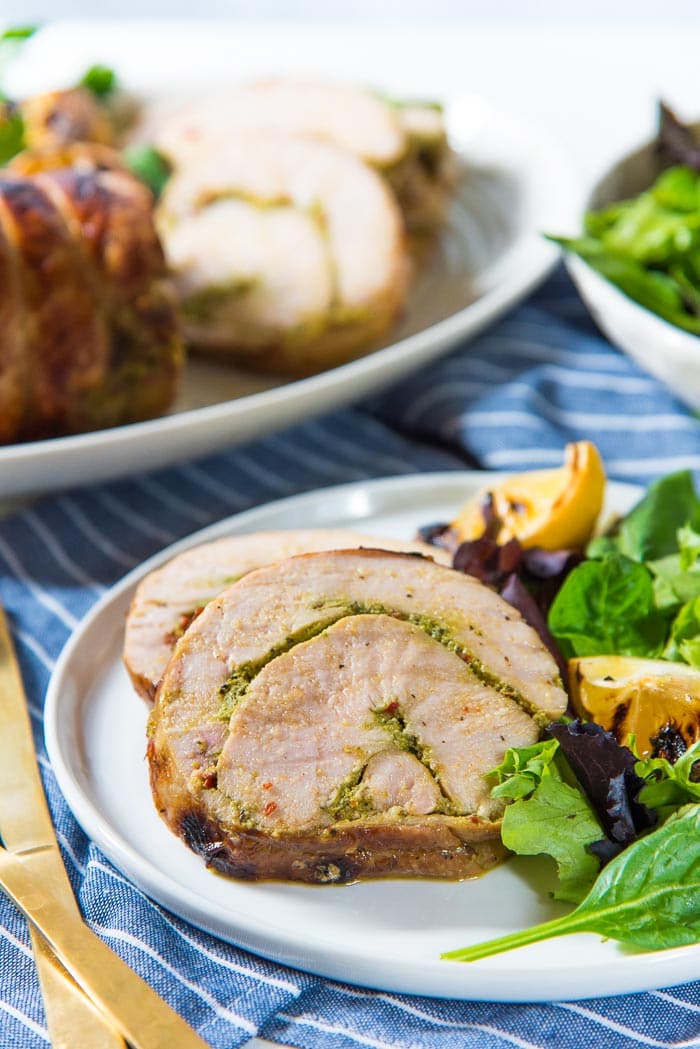
Why sous vide is one of the best ways to cook turkey breast
Turkey breast is notorious for its potential to go super dry after being roasted. Dry turkey breast is the main reason why most people prefer the thigh or leg portion of the bird, over the breast.
Turkey thigh is best cooked at 165°F for optimal food safety and to eliminate potential Salmonella and other pathogens. At an internal temperature of 165°F, a 7-log10 reduction of pathogen count is achieved. Meaning 99.99999% of bacteria are instantly destroyed at this temperature.
However, if you cook turkey breast at that temperature, it’ll come out dry. Sure, you can slather it with butter, but that’ll help the dryness only so much. Even with my slow roasted turkey roll in my previous post, I don’t exceed 162°F because this temperature ensures that the meat is deliciously succulent, while also being food-safe. However, the turkey continues to cook with residual heat and reach 165°F.
The sous vide, on the other hand, lets you cook the turkey breast at an even lower temperature, slowly, until the entire cut of turkey breast reaches that temperature, while keeping it perfectly cooked and food safe.
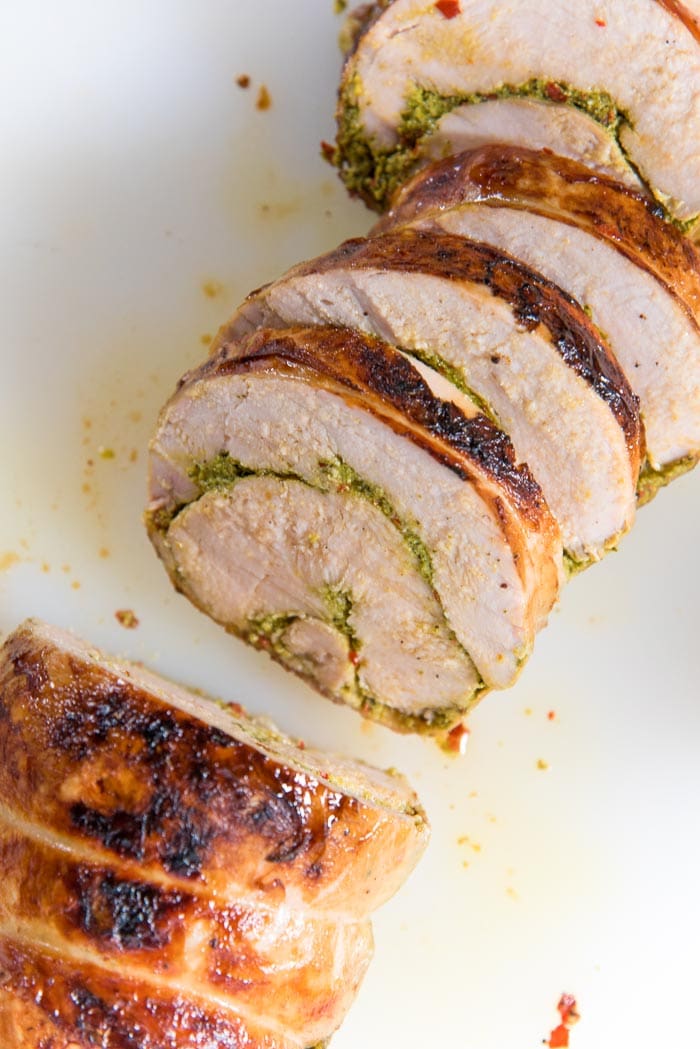
How long to sous vide turkey breast, temperature, and food safety
I did quite a bit of research on the best cooking conditions and sous vide times to perfectly cook a moist, tender turkey breast before developing this recipe.
According to the USDA FSIS cooking guideline for meat and poultry products, there is an instant 7-log10 reduction of Salmonella at an internal temperature of 165°F (73.9°C) for turkey meat with 1% all the way to 12% fat.
However, the same 7-log reduction of pathogens can be achieved by maintaining a lower internal temperature for a longer time. For example, you will need an internal temperature of 160°F (71.1°C) for 25-27 seconds to achieve the same level of bacteria elimination and make the cooked meat food-safe.
Similarly, at an internal temperature of 150°F (65.6°C), the turkey meat will require 3.7 to 4.9 minutes to fully cook to food-safe levels depending on the fat percentage.
You can check page 38 of this PDF document for time-temperature combinations for turkey products of different fat percentages to achieve pathogen lethality.
Kenji from Serious Eats also discusses this time-temperature dynamic of sous vide cooking turkey meat here and here.
So, if you can maintain an internal temperature of 150 – 155°F for at least 4 – 5 minutes, then the meat is fully cooked to food-safe levels while being perfectly tender and juicy without ever running the risk of drying out. Sous vide cooking easily guarantees that, and the whole process is mostly hands-off. What’s not to love?
How to sous vide turkey breast
How to prep the turkey breast for sous vide cooking
I shared a full guide on how to make a turkey roulade, from preparing the turkey breasts to making a turkey roulade. Starting from a full turkey breast cut (with two turkey breast sections, bone in and skin on), to a boneless turkey breast roll that’s ready to sous vide.
As you can imagine, this roulade shape guarantees even cooking throughout the meat, so that’s why I prefer to make a turkey breast roll / roulade for this sous vide recipe.
I prefer refrigerating the turkey roll (that’s rolled and tied up, and then wrapped with plastic wrap) overnight (up to 24 hours). The turkey roulade is then unwrapped and patted dry with paper towels prior to being cooked.
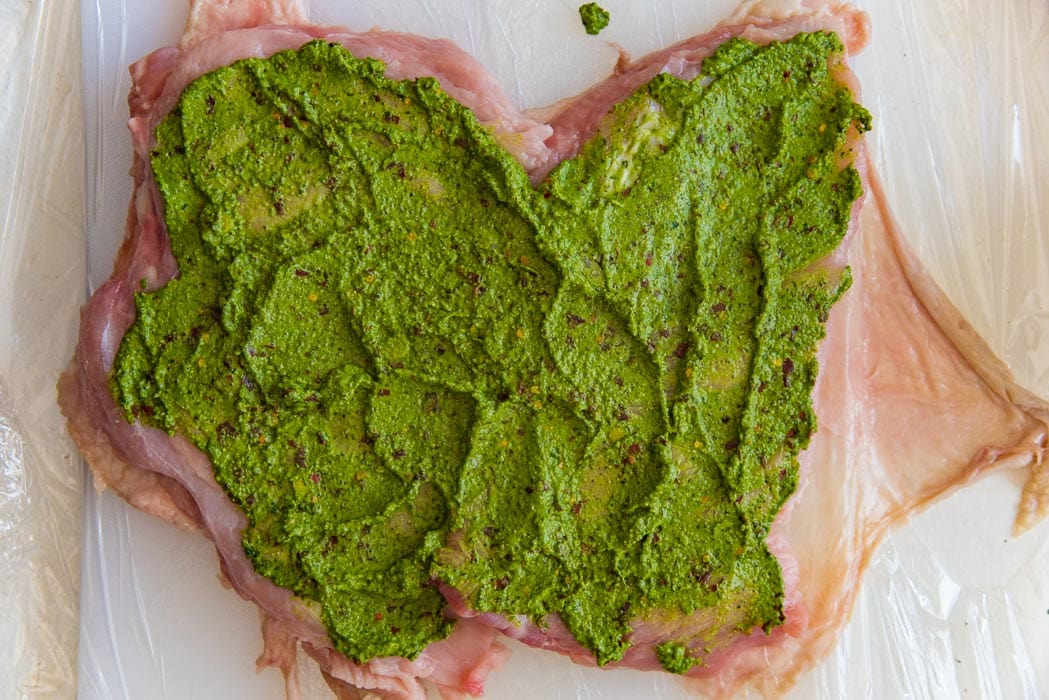
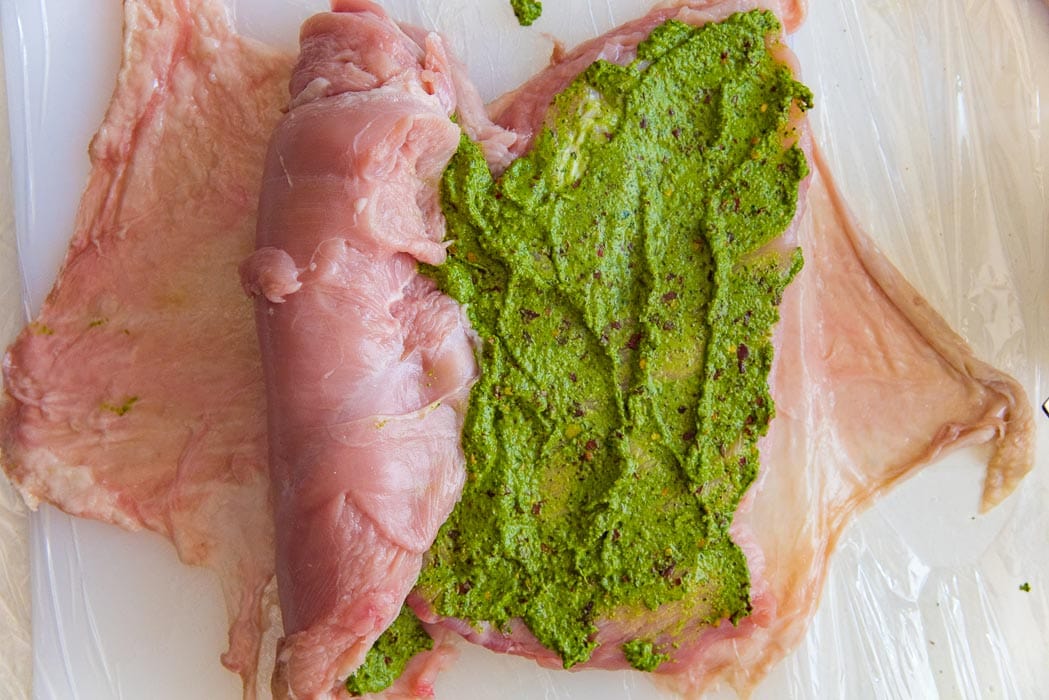
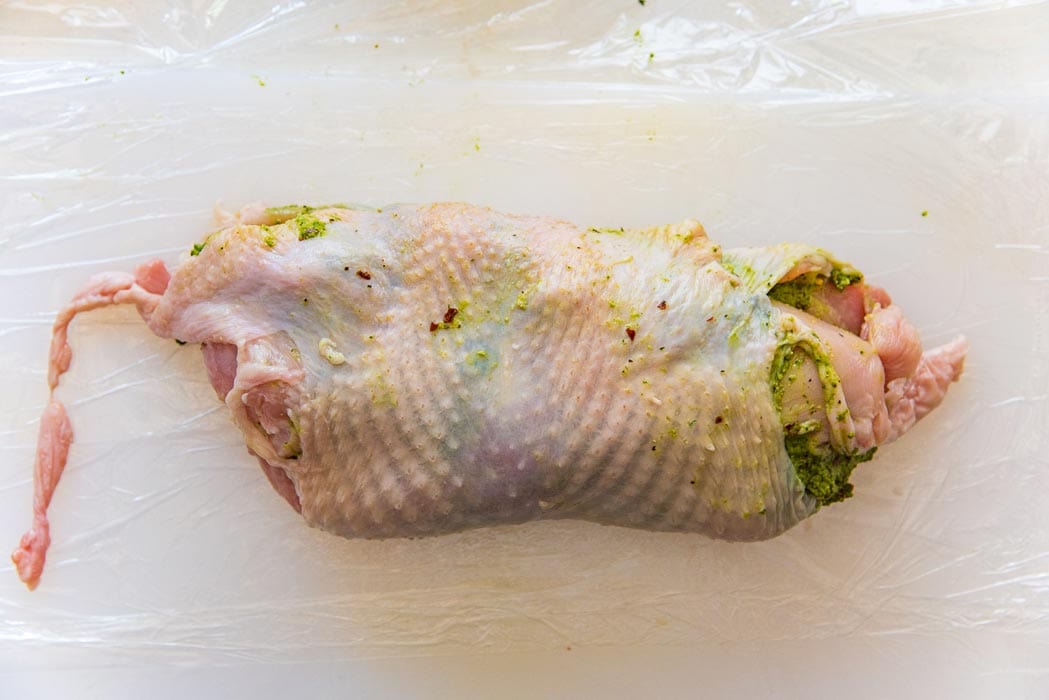
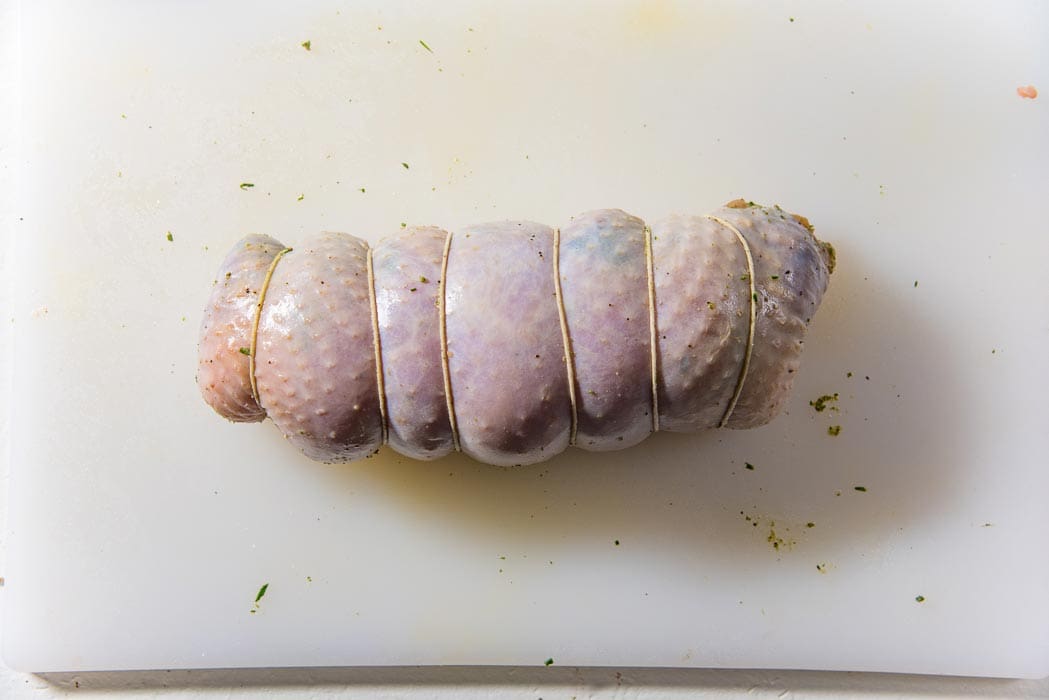
Here’s where sous vide turkey breast differs from my oven roasted turkey roll
Instead of oil, I like to rub a little softened butter on the turkey roulade, although you’re welcome to use oil for dietary or nutritional reasons.
I like the idea of the sous vide turkey breast being coated with butter for the entire cooking process. Since the cooking temp. is low, the butter won’t burn either.
Add some salt to keep it seasoned as well. The turkey roulade is then sealed in a plastic bag that can be immersed in the sous vide bath.
You can seal the turkey roll in a bag using either of the following two methods
- Using a vacuum sealer. This is my preferred method because I have a vacuum sealer, and it’s easier to make sure all the air is out of the bag, and it’s completely sealed.
- Water displacement sealing method. This method could be more convenient for most people. Not everyone has a vacuum sealer at home, but they can still “seal” their food for sous vide without a vacuum sealer. To do this,
- Place the turkey roulade in a large enough Ziploc bag. But do not close it.
- Fill the sous vide water container with water (leaving room for water displacement, so don’t fill it all the way to the top).
- Slowly lower the Ziploc bag with the turkey roulade inside, into the water container, with the opening sticking out of the water.
- When the entire turkey is submerged, with the opening sticking out of the water, close the bag and seal it well to ensure no water goes in. The water pressure will push all the air out of the bag, allowing a makeshift vacuum sealing method.
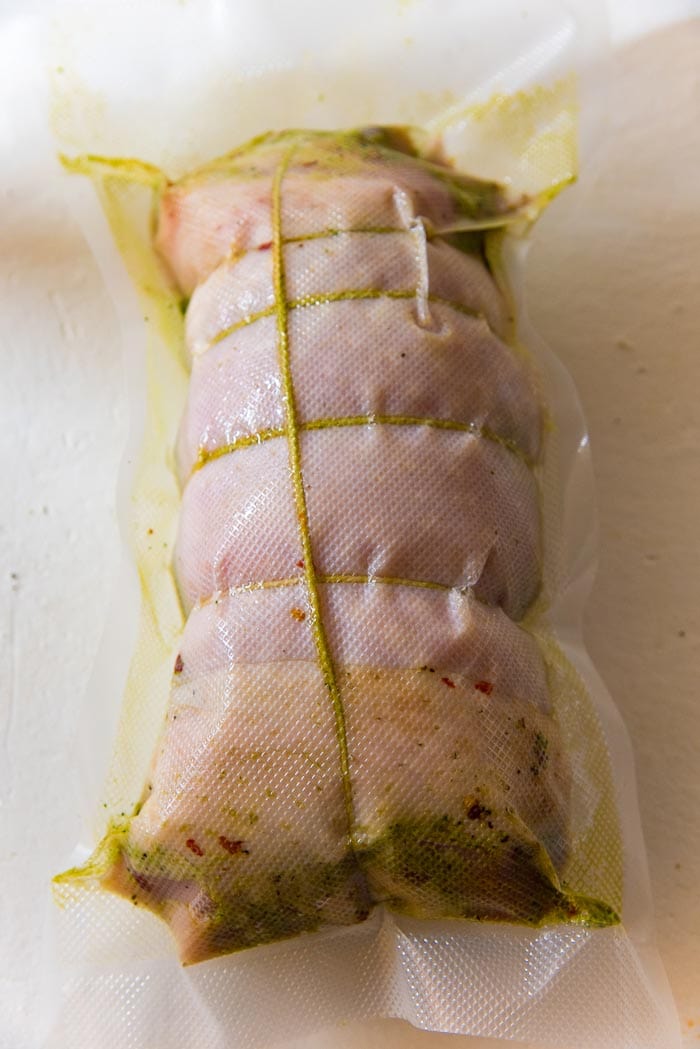
Setting up and cooking sous vide turkey breast
When the turkey roulade is sealed in snugly, attach your sous vide to the water container and set the temperature, and allow the water to reach that temperature.
Remember to close the sous vide (with a lid or using sous vide plastic balls) to prevent evaporation. After cooking the sous vide turkey breast for 5 hours at 150°F, the turkey is then removed from the bag and patted dry with paper towels.
How to caramelize the skin
At this point, you can caramelize the turkey breast skin in one of three ways.
- Pan fry the sous vide turkey breast – This will give you crispy skin and it will be fairly fast at high heat. Just make sure you don’t burn yourself from the splatter!
- Broil the sous vide turkey roulade in the oven – This method can be fast depending on how close it is to the heating elements. You have to keep an eye on it to make sure you don’t burn the turkey skin. Since broiling is an open heat method of cooking, there’s a risk of the turkey breast drying out slightly. However, with deep frying, this risk is minimal.
- Deep fry the turkey roulade – This will give you the most even and crispy results. You will need a big pot of oil to be able to deep fry this turkey breast in one go, or you can “shallow fry” the sous vide roulade by frying half of the roulade first and then flip it over to fry the other half. Again, beware of splattering!
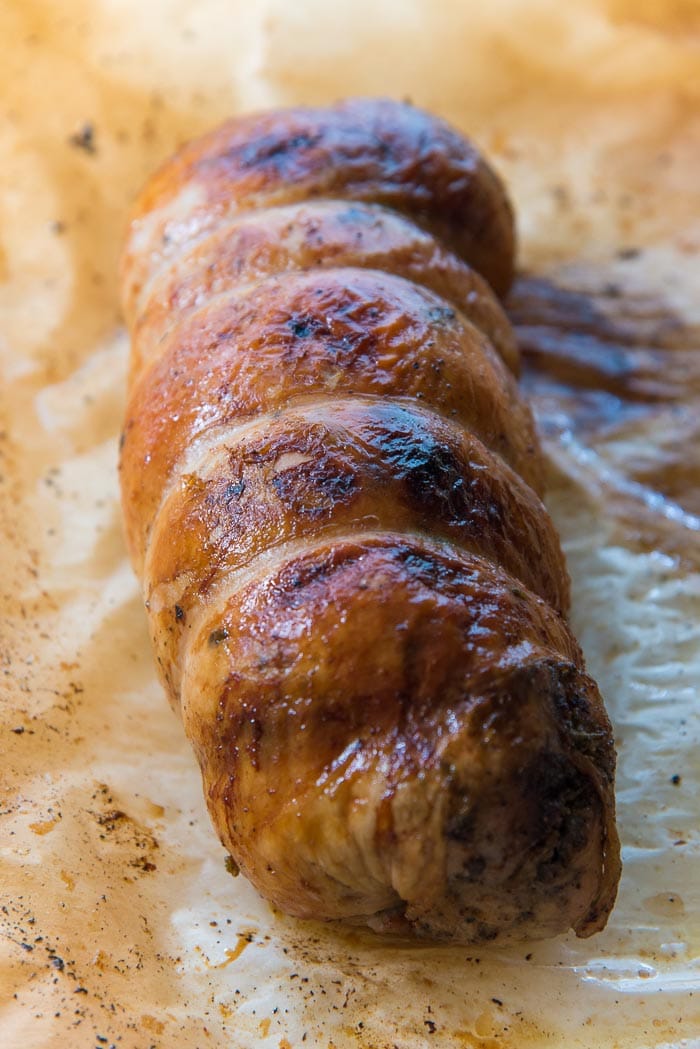
Juices from the sous vide bag
The sous vide bag will contain the juices (and the melted butter) from the sous vide turkey roll. This is equivalent to the pan drippings after oven roasting the turkey roulade. Don’t discard this!
You can use the juices to either pour directly over the sous vide turkey roulade slices, OR use it to make a flavorful turkey gravy.
You can pair this garlic and herb turkey roulade with any Thanksgiving side dish, or any roast dinner side dish. It’s a great alternative for a whole turkey for Thanksgiving, or even for Christmas. The leftovers are great for sandwiches and burgers the following day too.

Tips to ensure the most juicy, succulent sous vide turkey breast
The good news with this sous vide method is that this piece of equipment does all the work to ensure that you get tender, succulent turkey breast.
Here are the tips you need to follow to ensure that your sous vide turkey breast is as perfect as it can be.
- The spice or herb mix adds so much flavor to the roast as it cooks, so don’t skip it.
- Make sure that the roulade thickness is as even as possible. That’s the whole reason why we go with a roulade shape in the first place. This ensures that the whole roast has the same texture and juiciness throughout.
- Place the roast in a sous vide bag and seal it very well! I absolutely prefer to use a vacuum sealer here, instead of the water displacement method. That’s because the turkey roast needs to be sealed in well with no excess air! If the bag is not sealed properly or there is air in the bag, this air can expand as the turkey cooks. This can result in the turkey not cooking properly.
- Make sure the turkey roast is fully submerged in the water. You can use clips to clip the bag to the water vessel, and heavy items or other types of clips to keep the meat fully submerged.
- Don’t be concerned by the sous vide temperature. At 150 F (maintained for a period of time), the turkey will be fully cooked (as long as the meat is properly prepped and set up in the sous vide)! Since turkey meat starts to lose moisture beyond 160 F, the sous vide turkey roulade we cook here will guarantee that it’s the most tender, juicy turkey breast roast that you’ve ever had!
The importance of properly sealing the turkey roast
Unlike other sous vide recipes and cooking methods, cooking meat with a sous vide requires more care. This is because of the longer cooking time as well.
Any air pockets in the bag that can expand in the heat will cause the turkey roast to float. If the roast floats above water, then the turkey will not cook through.
This can also lead to the meat going bad, since it’s exposed to lower temperatures that are more optimal for bacteria growth.
Having a well-sealed turkey roast helps to fully submerge the meat in the water and cook it properly.
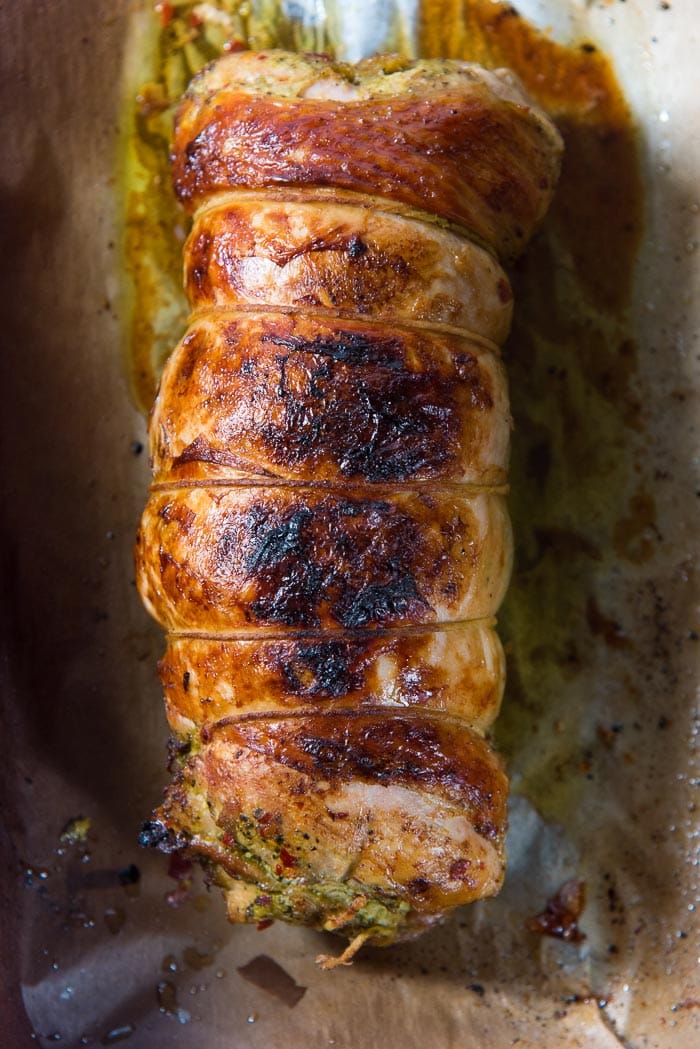
Flavor variations
While you can use any spice mix of your choice, I made a lemon, garlic and herb spice mix with lemon, garlic, cilantro and parsley. But the great thing about this sous vide turkey roulade recipe is that you can incorporate any flavor profile you like!
How about this sage and rosemary spice mix that I used for the slow roasted turkey roll?
Or this cajun spice mix that I used for this oven roasted turkey breast.
And this sage garlic butter paste from my slow cooker turkey breast recipe.
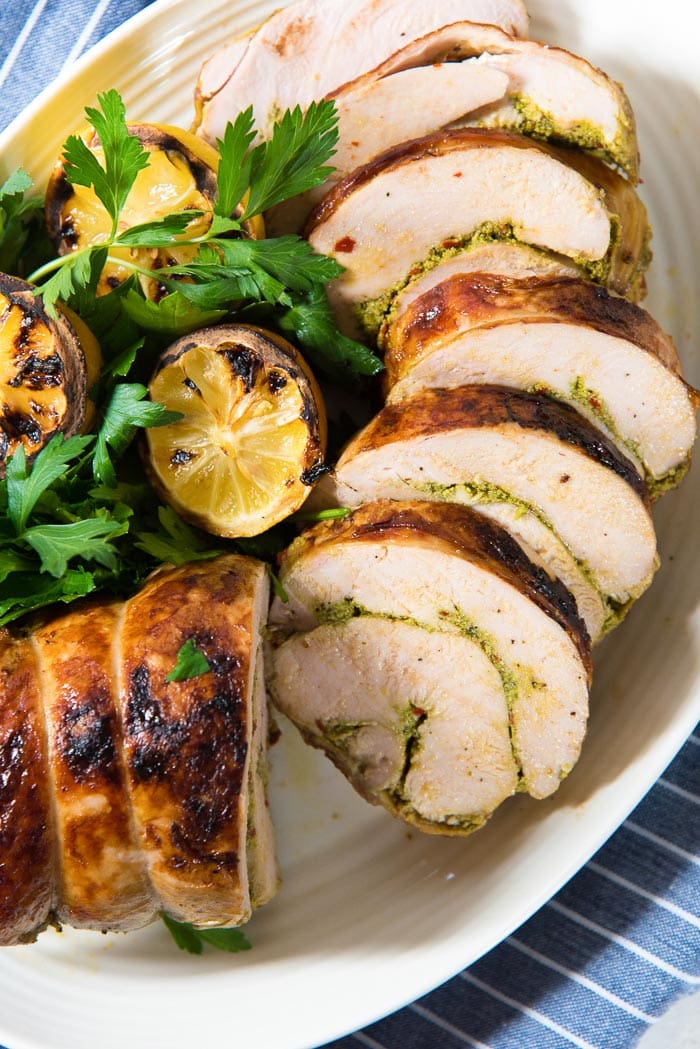
How to serve this sous vide turkey breast
Other turkey mains
I have shared several small dish turkey alternatives for Thanksgiving and Christmas.
- Like this easy oven roasted turkey breast
- Or if you prefer slow cooking your Thanksgiving turkey breast instead, then try my perfect slow cooker turkey breast.
- And for another amazing turkey roulade recipe, try my slow roasted turkey roll.
Sides
Here are some delicious traditional Thanksgiving side dishes and other sides to serve with this roasted turkey breast.
- Pear, sage and sausage stuffing
- Cranberry sauce
- Maple roasted brussels sprouts
- Green bean stir fry
- Cheddar corn biscuits
- Roasted delicata squash
- Panzanella salad
- Crispy cheese jalapeno bacon bites
Desserts
Delicious seasonal dessert recipes to pair with this sous vide turkey breast for Thanksgiving dinner (and Christmas too).
- Classic pumpkin pie
- Crustless pumpkin pie
- Butterscotch apple pie
- Perfect pavlova
- Chocolate roll cake
- Vanilla roll cake
- Red wine poached pears
- Saffron poached pears
- Chocolate stuffed poached pear tarts
- Spiced pumpkin cheesecake
- Fudgy pecan pie bars
- Bourbon butter pecan cake
- Pumpkin roll cake
- Fudgy chocolate brownies
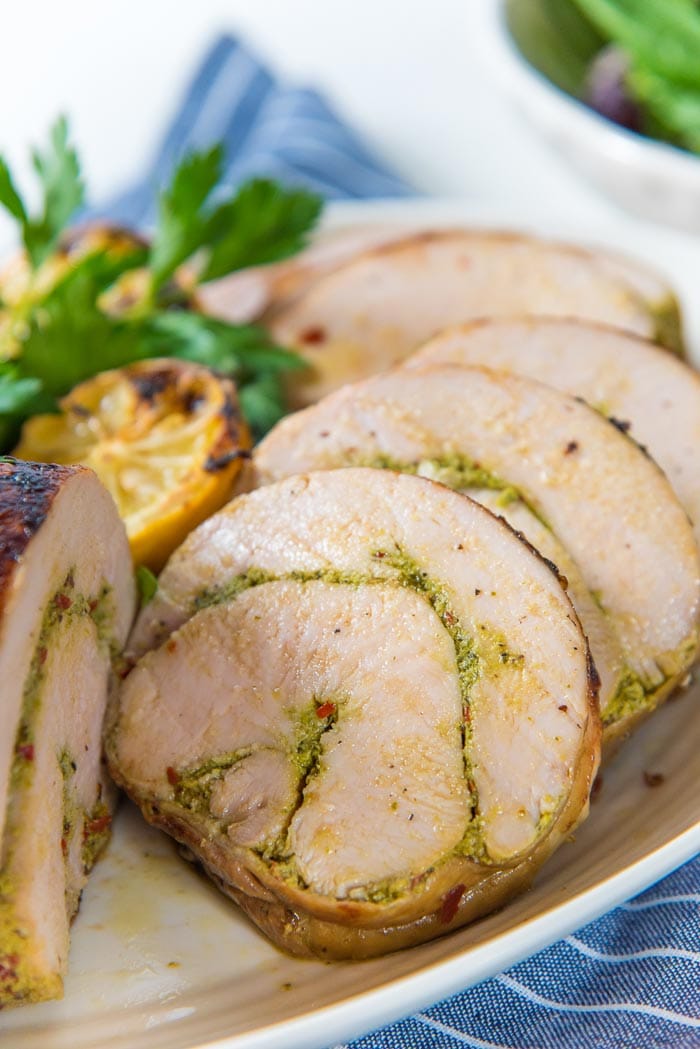
Storage instructions
This sous vide turkey breast roast should be stored the same way as any turkey roast.
Slice the leftovers prior to storing, so that it’s easier to only remove what you need.
FRIDGE – Leftovers will last about 3 days in the fridge, if stored in an airtight container. Just make sure that the temperature of the meat does not fluctuate between room temperature and chilled too often. Such fluctuations will increase the likelihood of the meat going bad. Only take what you need and reheat.
FREEZER – Leftovers will last in the freezer for up to 3 months. Portion the leftover turkey as you like. Wrap the portions separately. OR place the turkey in an airtight container that is freezer-friendly, but with wax paper or parchment paper layered in between the portions.
Wrapping the portions this way will ensure that the turkey won’t have freezer burns either.
Only remove the portions you want and reheat as needed.
As with any leftovers, check for changes in smell, taste, texture, or color. If there are any changes, please discard.
What do to with turkey leftovers
Here are some of my favorites options for roast turkey leftovers.
- Thanksgiving leftover strata
- Leftover turkey sandwich
- Creamy turkey shepherd’s pot pie
- Turkey croque monsieur
- Turkey filo rolls
- Thanksgiving leftover savory bread pudding
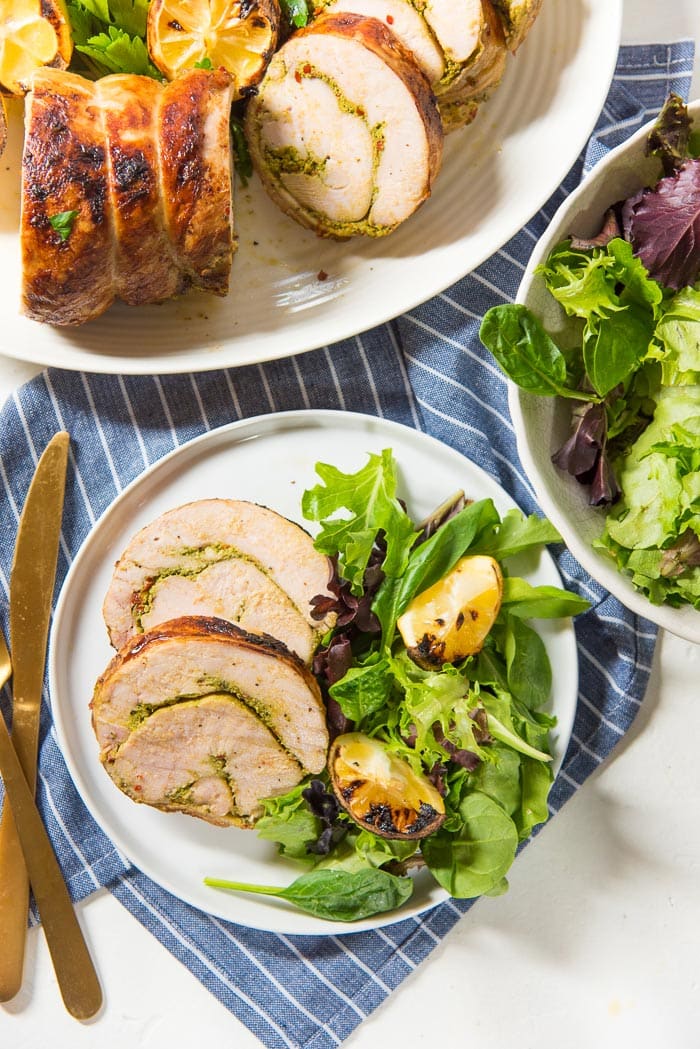
All the tools and equipment to make this sous vide turkey breast
- ANOVA SOUS VIDE COOKER (upgraded version of the sous vide machine I own).
- A more affordable sous vide cooker (I haven’t used this, so I cannot vouch for it, but it does have high Amazon ratings).
- 12 qt sous vide container.
- Sous vide container lid (with the corner flip where the sous vide cooker will be attached).
- Sous vide floating balls and clips.
- Vacuum sealer – the Food Saver model that I currently use and a more affordable model as well.
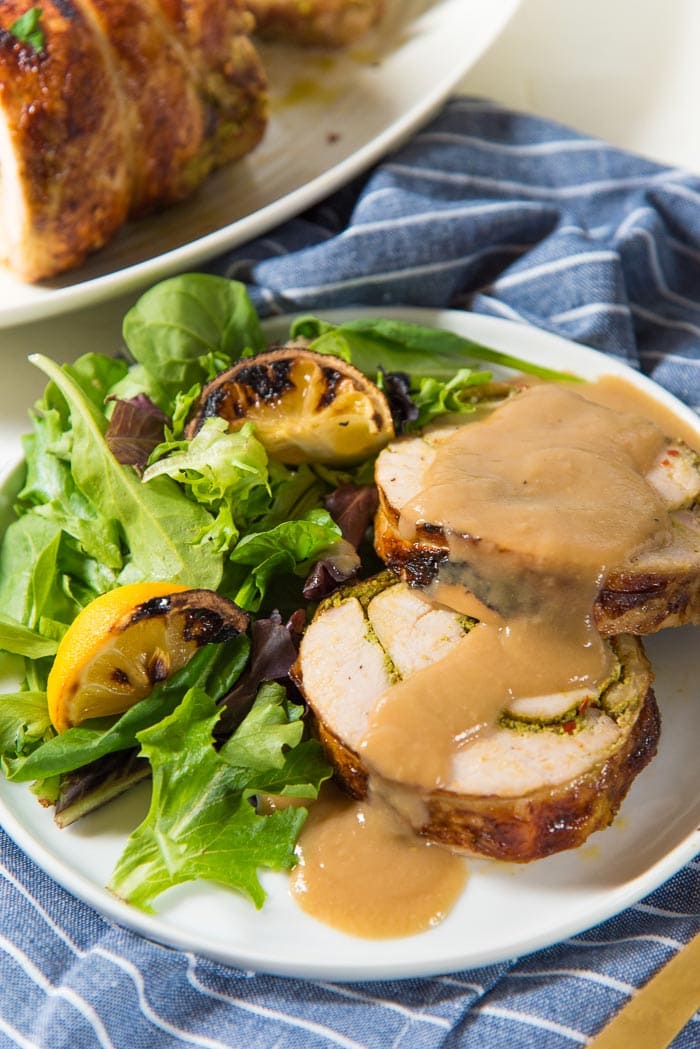
Looking for more recipes?Sign up for my free recipe newsletter to get new recipes in your inbox each week! Find me sharing more inspiration on Pinterest and Instagram.
Sous Vide Turkey Roulade
Ingredients:
Lemon garlic and herb mix
- ¼ cup parsley leaves you can add more if you like
- ⅓ cup cilantro leaves
- 1 tbsp brown sugar
- 10 garlic cloves
- Rind from 2 lemons
- Juice of 1 lemon
- 1 tsp salt
- ¼ cup oil or softened butter
- ½ tbsp chili flakes (crushed red pepper) optional
For the turkey roulade (the final turkey roulade will be 5 – 6 lbs)
- 1 whole turkey breast (2 turkey breast pieces) bone in and skin on
Turkey gravy
- 2 cups unsalted chicken stock between 2 – 3 cups
- 3 tbsp butter
- 3 tbsp flour
- Generous pinch of black pepper
- More salt if needed
Instructions:
For the lemon and garlic herb mix
- Place all the ingredients in a small food processor and process until you have a paste. Transfer this herb paste into a small bowl and cover and set aside until needed.¼ cup parsley leaves, ⅓ cup cilantro leaves, 1 tbsp brown sugar, 10 garlic cloves, Rind from 2 lemons, Juice of 1 lemon, 1 tsp salt, ¼ cup oil, ½ tbsp chili flakes (crushed red pepper)
Lemon garlic herb sous vide turkey breast
- Prepare the turkey roulade by following the detailed guide here on how to make turkey roll.1 whole turkey breast (2 turkey breast pieces)
- When the turkey breast has been butterflied and shallow cuts have been made and the skin prepped, rub all of the lemon herb mix over the turkey breast as shown in pictures in the post.
- Roll up the turkey breast (as noted in the guide on how to make a turkey roll), and wrap it with the turkey skin.
- Using kitchen twine, secure the turkey roulade and wrap it with plastic wrap. Place the turkey roulade in the fridge overnight, up to 1 day. (You can keep it at room temperature for up to 1 – 2 hours and then roast it, but storing it overnight in the fridge is better to secure the shape of the turkey roulade.)
The following day
- Remove the turkey roulade from the fridge.
- Fill your sous vide container (I use a 12 qt container) with water and attach your sous vide cooker. Set the temperature to 150°F and cover the sous vide container (with a lid or sous vide floating balls).
- Remove the turkey roulade from the plastic wrap and pat dry with paper towels until there’s no moisture on the surface.
- Rub the surface of the turkey roulade with butter (or oil), and sprinkle the surface with kosher salt and black pepper (black pepper is optional).Generous pinch of black pepper, More salt
- Place the turkey roulade in a large vacuum bag. Vacuum seal the turkey roulade.
- When the sous vide water reaches the correct temperature, lower the turkey roulade into the water and make sure it’s completely submerged in the water. Cook the roulade for 5 hours.
- Remove the turkey roulade from the sous vide container, and place it in an ice bath to cool down for about 10 minutes.
- Open the vacuum bag and remove the turkey roulade, and pour the “drippings” (that might be congealed because of the ice bath) into a small bowl or jug. You can use this to make gravy or use it like au jus for the roulade.
- Pat dry the surface of the turkey roulade with paper towels. You can caramelize the skin in 3 different ways (see below).
- BROILER – Set the broiler setting to high (grill setting in the oven). Place the turkey roulade on the broiler plate, about 3 – 4 inches away from the broiler. Let the skin caramelize all over by turning the turkey roulade every few minutes. Keep a close eye on the roulade in the broiler, because caramelization happens fast!
- PAN FRYING – Add some oil into a large non-stick skillet (add enough oil to cover the bottom of the pan with ½ inch of oil). Heat over medium-high heat. When the oil is hot enough, carefully place the turkey roulade on the pan, and let the skin caramelize in the heat. Rotate the roulade every few minutes to allow the entire surface to caramelize. PLEASE BE CAREFUL as the oil may spit. So please take precautions to not burn yourself. Remove from the the pan and place it on a wire rack to drain excess oil.
- DEEP FRYING – Add enough oil into a large pot (large enough to accommodate the whole turkey roulade), so that the oil comes at least half-way up the turkey roulade (about 3 – 4 inches). Heat the oil to about 380°F and carefully place the turkey roulade in the hot oil. Allow the turkey roulade skin to caramelize (about 2 – 3 minutes), and then flip it over to caramelize the other side. PLEASE BE CAREFUL as the oil may spit. So please take precautions to not burn yourself. Remove from the oil and place it on a wire rack to drain excess oil.
- The sous vide turkey breast is now ready to be served. Slice it into ½ inch slices and arrange on a platter to serve immediately. Slice the roulade only when you’re ready to serve it to prevent drying out. Serve with gravy and other Thanksgiving side dishes.
Turkey gravy
- Measure how much pan drippings you get from the turkey roulade in a measuring cup.
- Add enough turkey stock / broth (or chicken stock / broth), to make 2 cups of liquid.2 cups unsalted chicken stock
- Place the butter in a pot and let it melt over medium heat. When the butter has melted, add the flour, and whisk until there are no lumps in the flour. Keep stirring this roux until the color changes to brown, and it smells quite nutty.3 tbsp butter, 3 tbsp flour
- Whisk in the stock and pan drippings and black pepper, and whisk until there are no flour lumps. Bring the gravy to a boil and then lower the heat. Cook until you have a gravy with a desired consistency. If the gravy becomes too thick, you can add more stock to thin it out. Taste the gravy and season with extra salt if needed.Generous pinch of black pepper, More salt
- Pour the gravy into a bowl and cover with plastic wrap. Make sure the plastic wrap is touching the surface to prevent any gravy skin from forming on top.
Nutrition Information:
“This website provides approximate nutrition information for convenience and as a courtesy only. Nutrition data is gathered primarily from the USDA Food Composition Database, whenever available, or otherwise other online calculators.”
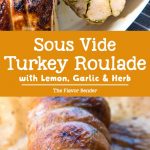
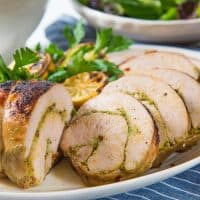
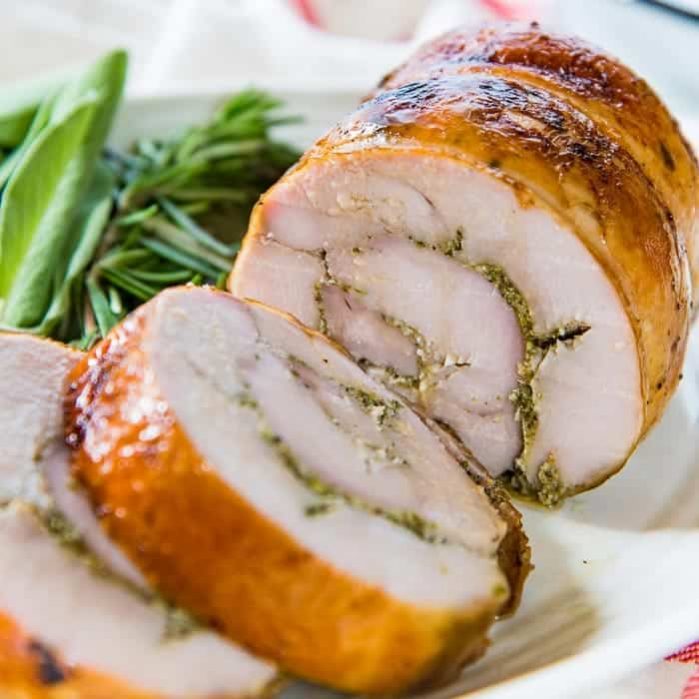
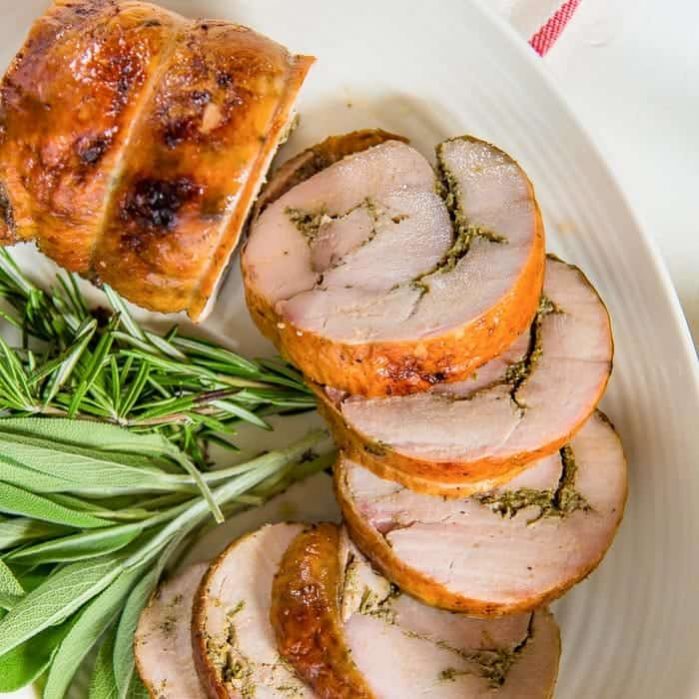

Judy says
Hi Dini, I’m hoping you can answer my question please.
I was not able to buy the usual turkey buffet so I have a small deboned turkey, I intend to make 2 roulades but not sure how the meats will cook together .. breast thigh ect…
My question is
Judy keys says
Hello from Australia.. I did this recipe for Christmas & used what is known here as a turkey buffet. After removing the breasts from bones & including turkey fillets I wrapped two separate breasts in prosciutto with the stuffing as per recipe.
I roasted leftover carcass on a bed of onion carrot, parsley.. then made gravy from the pan juices … it was the best ever
Because I had two roulades cooking time was reduced to 4 hours
Delicious
Judy says
Could I wrap this turkey roulade in Prociutto
Instead of turkey skin?
Dini says
Hu Judy
Yes! You could use prosciutto instead of the skin too.
Deborah Davis says
The roulade was great, but I have given up on getting crispy skin on a turkey that is not roasted or rotissuried. I chose to fry it in an electric skillet. It browned, but did not crisp. Had it stayed in long enough to crisp the skin, it would have overcooked the turkey. This will likely be my Thanksgiving recipe this year.
Alisa Ng says
Hi, we loved this recipe! However it turned out I could only get one turkey breast bone in. It turned out anyways but I’d like it to be a tad more juicy.
Do you have temperature adjustments for one breast roulade?
We cooked it at 150F for 5hrs.
Making this again on the 29th for friends. Thank you!
Dini says
Hi Alisa!
I’m so glad that you liked this recipe!
I usually prefer not to go below 150°F. BUT, with sous vide it is possible to go lower to about 145°F or 140°F. According to USDA regulations, cooking turkey with up to 12% fat, to an internal temperature of 145°F requires it to be kept at that temperature for 15 minutes for a 7-log lethality of salmonella, and 35 minutes at 140°F. This can provide a juicier turkey roulade. But I would still cook the turkey breast roulade for at least 3 hours for a single breast (up to 5 hours), and at least 4.5 hours for a double breast (up to 5 hours) in a sous vide set at 142 (for a 140°F internal temperature), and 147°F (for 145°F internal temperature) to make sure that it has cooked through and is safe to eat.
With a sous vide, you really don’t run the risk of overcooking, so I wouldn’t be too concerned even if I do go a little over 5 hours too. I hope that helps!
Victoria says
Hi, I have a question. I read the Serious Eats article re: turkey breast sous vide and the cook times seem different for the 150°F cooking temp. It looks like Serious Eats article recommends 2 1/2 hr cook time and your recipe says 5 hr for the same weight turkey (approx 5lbs from what I could tell). Am I misunderstanding the recipe? I really want to try sous vide technique but I don’t want to mess up the main event! Please help! Thanks.
Dini says
Hi Victoria,
If you’re cooking a turkey breast (not a roulade), then yes, I wouldn’t cook it beyond 2.5 – 3 hours. However, with a roulade, because it has a filling in the middle as well, you need to cook it longer to make sure the low heat propagates throughout the roulade and cooks it evenly. That’s why I cook it for 5 hours. I would have been comfortable taking it out at 4.5 hours as well. BUT importantly, there is NO risk of overcooking or drying out turkey breast with a sous vide, so that little bit of extra time (as long as it’s not like half a day!) won’t make a difference beyond absolutely ensuring that the turkey is food-safe. That’s the beauty of the sous vide technique.
So if you are cooking a turkey roulade, I would recommend cooking it for at least 4.5 – 5 hours. If you’re cooking a turkey breast (boneless, skin on or skin off), then I would recommend 2.5 – 3 hours. Hope that helps!
Shadi Hasanzadenemati says
The herb mix for this turkey roulade is perfect and I love the sous vide technique! Can’t wait to try!
Lisa says
Thanks for all the amazing tips for preparing this turkey roulade roast. I’m loving this method much more than a simple roast.
AM says
this sounds amazing. Do you have any make-ahead tips? How long ahead can the roast be prepped, vacuumed and refrigerated before it is cooked sous vide? Can it remain in the vacuum bag and refrigerated after it is cooked sous vide for a few days and then browned and warmed before serving? Could it be frozen at any stage? Thanks!
Dini says
Hi AM
Thank you! 🙂
You can refrigerate the sous-vide turkey breast in the vacuum sealed bag for up to 3 days! If you do decide to freeze it (up to 10 days), you will have to thaw it out in the fridge (which can take 1 – 2 days). Either way you will have to brown and reheat the turkey breast in the oven before serving, but if you do have an instant read thermometer, make sure the turkey breast doesn’t overcook and dry out.
I hope that helps!
Lisa says
Hi Dini! Just re this response, I wanted to clarify- you can do the 5 hour Sous vide cook, then leave it in the vacuum sealed bag in the fridge for up to 3 days; then pull it out to heat/ brown in the oven to serve??
Dini says
Hi Lisa
You can store the turkey roulade in the fridge. You can reheat and brown the turkey roulade in the oven too. However, you will need to do this at a lower temperature to ensure the turkey roulade reheats through properly. That’s why a meat thermometer is recommended to monitor the internal temperature as you reheat the roulade.
You can also sous vide the refrigerated roulade to bring the temperature back up and then broil it in the oven to caramelize.
Hope that helps!